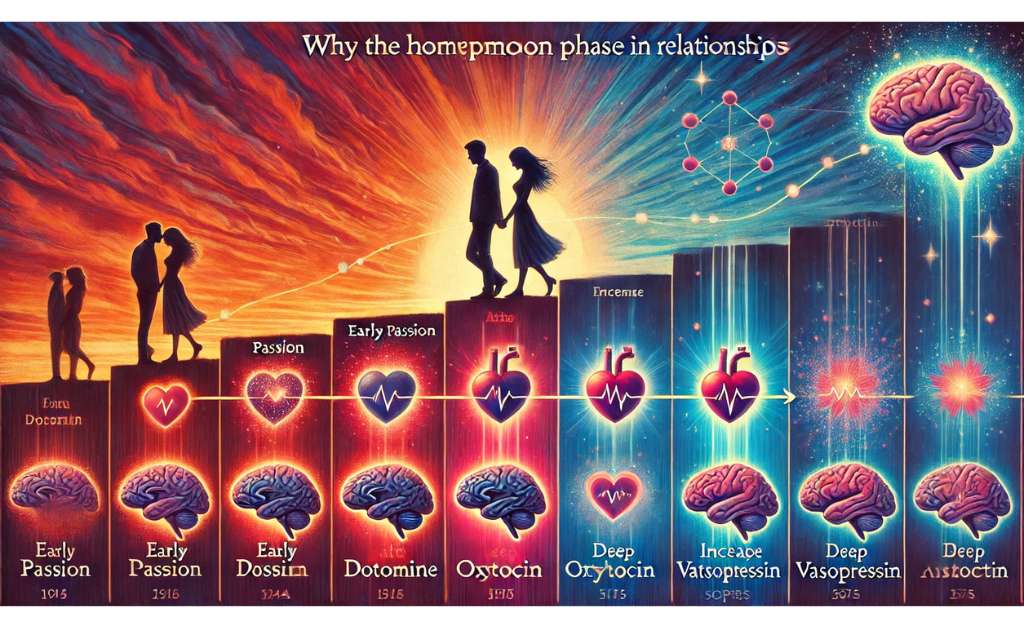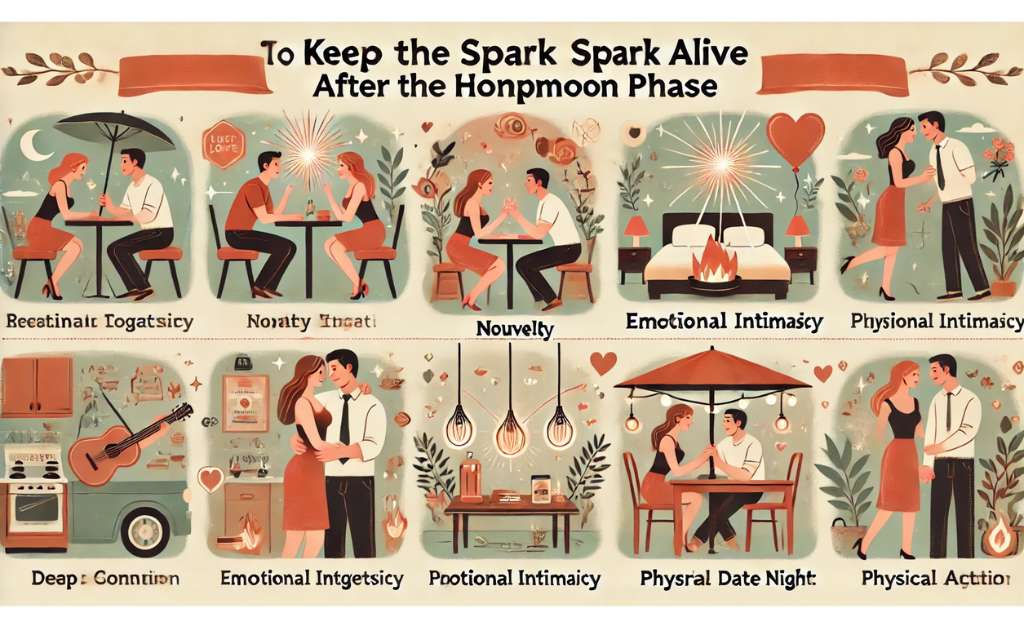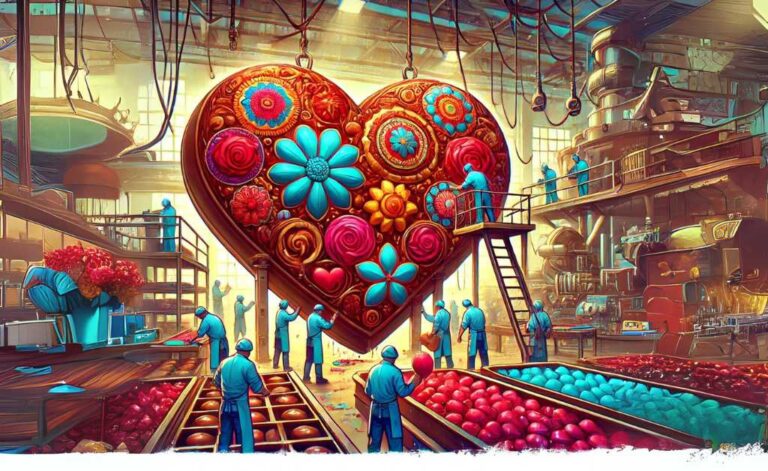The “Honeymoon Phase”: How Long Does It Last & Why?
Table of Contents
ToggleThe “Honeymoon Phase” Explained: How Long Does It Last & Why?
🔹 Introduction: The Science & Psychology of the Honeymoon Phase
The honeymoon phase is often described as the most thrilling part of a romantic relationship—when love feels effortless, passion is at its peak, and everything about your partner seems perfect. But what actually causes this intoxicating feeling? And why does it eventually fade for most couples?

Characteristics of the Honeymoon Phase
The honeymoon phase is characterized by several key features:
- Intense emotions: Feelings of love, passion, and excitement are heightened during this period. Everything feels new and exciting, and couples often experience a strong desire to be together.
- Idealization: Partners tend to see each other through rose-tinted glasses, focusing on positive qualities and overlooking flaws. This idealization creates a sense of perfection and can contribute to the feeling of being “head over heels” in love.
- Increased intimacy: Physical and emotional intimacy are often heightened during the honeymoon phase. Couples may spend a lot of time together, engage in frequent physical affection, and share deep personal thoughts and feelings.
- Reduced conflict: Disagreements and conflicts are less common during this period, as couples are more focused on building connection and enjoying each other’s company.
- Optimism and hope: There’s a sense of optimism and hope for the future of the relationship. Couples often feel confident that their love will last and that they have found their “soulmate.”
The Science Behind the Honeymoon Phase
The honeymoon phase is not just a subjective experience; it has a biological basis. When we fall in love, our brains release a cocktail of neurochemicals, including:
- Dopamine: This neurotransmitter is associated with pleasure, reward, and motivation, creating feelings of euphoria and excitement.
- Oxytocin: Often called the “love hormone,” oxytocin promotes bonding, trust, and attachment.
- Norepinephrine: This neurotransmitter increases alertness, focus, and energy levels, contributing to the feeling of being “love-struck.”
These neurochemicals create a powerful cocktail that fuels the intense emotions and behaviors associated with the honeymoon phase.
Duration and Evolution of the Honeymoon Phase
The duration of the honeymoon phase can vary significantly from couple to couple, typically lasting anywhere from a few months to two years. As the initial intensity subsides, the relationship transitions into a more stable and realistic phase. This doesn’t necessarily mean the end of love; it signifies a shift from the infatuation stage to a deeper, more mature form of love characterized by commitment, understanding, and acceptance.
Factors Influencing the Honeymoon Phase
Several factors can influence the duration and intensity of the honeymoon phase:
- Individual Differences: Personality traits, attachment styles, and past relationship experiences can all play a role.
- Relationship Dynamics: The level of communication, shared values, and mutual support within the relationship can influence how long the honeymoon phase lasts.
- External Factors: Stressful life events, such as job loss or family issues, can impact the honeymoon phase and the overall relationship.
Can We Relive the Honeymoon Phase?
While the initial intensity of the honeymoon phase may fade, couples can take steps to maintain a sense of excitement and connection in their relationship. This can involve:
- Prioritizing Quality Time: Make time for each other, even amidst busy schedules.
- Trying New Things Together: Engage in novel activities and experiences to keep the spark alive.
- Expressing Appreciation: Regularly express gratitude and affection for each other.
- Communicating Openly: Maintain open and honest communication to address challenges and nurture emotional intimacy.
This article will discuss Everything of honeymoon phase From hormonal surges to psychological idealization, science reveals that the honeymoon phase is not just emotional—it’s deeply biological. In this article, we’ll explore in detail:
✔ How long the honeymoon phase typically lasts
✔ Why it happens—biological, psychological, and evolutionary explanations
✔ The brain chemistry & hormones behind romantic euphoria
✔ Why it fades & how couples can sustain passion
✔ Proven ways to keep the spark alive beyond the honeymoon phase
✔ FAQs: Common questions & expert-backed answers
By the end, you’ll have a scientific and psychological understanding of the honeymoon phase—why it happens, how to navigate it, and how to maintain a deep, fulfilling love.
1️⃣ What Is the Honeymoon Phase & How Long Does It Last?

🔹 The Defining Features of the Honeymoon Phase
The honeymoon phase is the first stage of romantic love, marked by intense emotions, infatuation, and idealization. During this time:
✅ Everything feels exciting & effortless: You can’t get enough of your partner, and the relationship seems perfect.
✅ Frequent communication & affection: Texts, calls, and physical intimacy are abundant.
✅ Overlooking flaws: You tend to focus on your partner’s strengths while minimizing their weaknesses.
✅ Feelings of euphoria & obsession: Thoughts of your partner dominate your mind.
💡 Expert Insight:
“The honeymoon phase is designed by evolution to create strong emotional bonds. It fosters intense attraction, which later stabilizes into long-term attachment.” — Dr. Helen Fisher, Anthropologist & Love Researcher
📖 Further Reading: Journal of Social and Personal Relationships on Early-Stage Love
🔹 How Long Does the Honeymoon Phase Last?
While there’s no universal timeframe, research suggests that the honeymoon phase lasts between 3 months to 2 years, depending on the couple and external factors.
| Duration | Characteristics |
|---|---|
| 3-6 months | Most intense phase, obsession, high passion |
| 6-12 months | Still exciting but slight decrease in intensity |
| 12-24 months | Brain chemistry stabilizes, reality sets in |
📌 Scientific Study:
A 2021 study from the Journal of Social and Personal Relationships found that passionate love starts declining after 12-18 months as the brain adjusts to emotional stability.
💡 Final Takeaway: The honeymoon phase isn’t meant to last forever—but love doesn’t disappear, it simply evolves.
2️⃣ Why Does the Honeymoon Phase Happen?

🔹 Biological Explanation: Love is an Addiction
Love is more than an emotion—it’s a biological drive designed for human survival and reproduction. The honeymoon phase happens because our brains flood us with feel-good chemicals that make us crave closeness with a partner.
✅ Key Brain Chemicals at Work:
✔ Dopamine: Creates pleasure, reward, and addiction-like attraction.
✔ Oxytocin: Strengthens trust and bonding (“the cuddle hormone”).
✔ Norepinephrine: Increases alertness, excitement, and heart rate.
✔ Serotonin: Temporarily drops, making us obsessively think about our partner.
📌 Scientific Study:
A 2019 Harvard study found that early-stage romantic love activates the same brain pathways as addictive substances like cocaine. This explains why people in the honeymoon phase feel obsessed, euphoric, and unable to think about anything else.
💡 Expert Insight:
“Romantic love is a survival mechanism. The brain rewards us with intense pleasure to encourage bonding and reproduction.” — Dr. Lucy Brown, Neuroscientist
🔹 Psychological Explanation: Idealization & “Love is Blind” Effect
Our brains don’t just create chemical highs—they also change how we perceive reality.
✅ During the honeymoon phase:
✔ We idealize our partner: We focus on their positive traits while ignoring flaws.
✔ We project our desires: We assume they’re “perfect” because they match what we want.
✔ We crave constant reassurance: Their attention gives us dopamine boosts, reinforcing attraction.
📌 Example:
A 2021 study in the Journal of Personal Relationships found that couples in the honeymoon phase rate their partner as more attractive, intelligent, and kind than objective measures suggest.
💡 Final Takeaway: The honeymoon phase happens because our brain tricks us into falling in love—but this illusion fades as reality sets in.
🔹 Evolutionary Explanation: Why Love Works This Way
From an evolutionary standpoint, the honeymoon phase is nature’s way of ensuring strong emotional bonds between partners.
✅ Why it happens from an evolutionary perspective:
✔ Increases chances of reproduction: Passionate attraction leads to more mating opportunities.
✔ Ensures parental cooperation: Early bonding helps raise offspring together.
✔ Strengthens long-term survival: Humans thrive in pairs—our brains reinforce emotional closeness.
📌 Scientific Study:
A 2022 evolutionary psychology review found that species with strong social bonds, including humans, have higher survival rates and reproductive success.
💡 Final Thought: Love isn’t random—it’s biologically and evolutionarily programmed to keep us together.
3️⃣ Why Does the Honeymoon Phase Fade?

🔹 The Psychological Shift: From Fantasy to Reality
As thrilling as the honeymoon phase is, it cannot last forever—not because love disappears, but because our brains adapt. Over time, our perception of our partner shifts from idealization to realism.
✅ Key Reasons Why the Honeymoon Phase Fades:
✔ Neural Adaptation: The brain stops reacting as strongly to your partner’s presence over time.
✔ Increased Familiarity: The relationship becomes predictable, reducing excitement.
✔ Shift to Emotional Stability: The brain transitions from dopamine-driven passion to oxytocin-driven attachment.
✔ Daily Responsibilities: Real-life stressors (work, family, bills) begin influencing the relationship.
📌 Example:
A 2022 study from the Gottman Institute found that couples who assume passionate love must last forever are more likely to experience dissatisfaction when the honeymoon phase fades.
💡 Expert Insight:
“Romantic passion is designed to transition into deep emotional bonding. The couples who adapt to this shift are the ones who stay together.” — Dr. John Gottman, Relationship Expert
🔹 The Brain’s Role: How Chemistry Evolves Over Time
Phase 1: Dopamine-Driven Passion (Honeymoon Phase)
💡 Dopamine floods the brain, making love feel exciting, addictive, and euphoric.
✔ You crave your partner constantly
✔ Sexual attraction is heightened
✔ Your partner seems flawless
📌 Scientific Study:
A 2019 Harvard study found that romantic obsession mimics addiction—activating the same reward circuits as cocaine.
Phase 2: Oxytocin & Vasopressin Take Over (Long-Term Love)
💡 Over time, dopamine levels decrease, while oxytocin and vasopressin (bonding hormones) increase.
✔ Emotional attachment deepens
✔ Romantic obsession fades into comfort and security
✔ You see your partner’s flaws—but love them anyway
📌 Scientific Study:
A 2021 neuroscience review found that couples in long-term relationships have higher oxytocin levels than new couples, indicating a shift from passion to deep attachment.
💡 Final Takeaway: Love doesn’t fade—it transforms. The challenge is keeping passion alive while building deeper emotional connection.
4️⃣ How to Keep the Spark Alive After the Honeymoon Phase

The fading of the honeymoon phase doesn’t mean the romance is over—it simply shifts into a new phase of deeper emotional connection. The key to a long-lasting relationship is keeping the spark alive while fostering emotional intimacy and security.
🔹 The Science of Long-Term Passion
While passion naturally declines over time, research shows that couples can reignite the excitement by stimulating the brain’s reward system in new ways.
✅ Key Strategies for Keeping Passion Alive:
✔ Introduce novelty: New experiences increase dopamine levels, mimicking the honeymoon phase.
✔ Maintain physical intimacy: Physical touch and sex release oxytocin, deepening emotional bonds.
✔ Prioritize emotional connection: Open communication and shared vulnerability strengthen relationships.
✔ Keep dating each other: Engaging in fun and meaningful activities together keeps the romance alive.
📌 Scientific Study:
A 2020 study in the Journal of Personality and Social Psychology found that couples who engage in novel activities together report higher satisfaction and rekindled passion compared to those who fall into repetitive routines.
💡 Expert Insight:
“Passion isn’t just about physical attraction—it’s about shared excitement, novelty, and deep emotional connection.” — Dr. Esther Perel, Relationship Psychologist
🔹 Practical Strategies to Rekindle Romance
1️⃣ Create New Experiences Together
One of the biggest reasons passion fades is predictability. By introducing new experiences, couples can stimulate dopamine production, mimicking the excitement of the honeymoon phase.
✔ Try a new hobby together (dancing, cooking, hiking, etc.).
✔ Plan surprise date nights or weekend getaways.
✔ Engage in adrenaline-boosting activities (roller coasters, escape rooms, travel adventures).
📌 Example:
A 2021 study by Stony Brook University found that adventurous activities increase attraction by recreating the physiological arousal experienced in early-stage love.
2️⃣ Prioritize Physical & Emotional Intimacy
Touch plays a vital role in maintaining attraction and connection over time.
✔ Hold hands, hug, and kiss daily.
✔ Schedule intimate time together without distractions.
✔ Experiment with new ways to connect physically, inside and outside the bedroom.
📌 Scientific Study:
A 2019 study published in Archives of Sexual Behavior found that couples who prioritize non-sexual touch (like cuddling and holding hands) have higher relationship satisfaction and stronger long-term passion.
3️⃣ Keep Flirting & “Wooing” Each Other
Just because the honeymoon phase fades doesn’t mean you should stop flirting!
✔ Send playful texts or flirty messages.
✔ Compliment your partner as if you just started dating.
✔ Surprise them with thoughtful gestures, like love notes or small gifts.
📌 Example:
A study from the University of Texas found that couples who flirt and maintain humor in their relationship experience longer-lasting passion than those who don’t.
4️⃣ Communicate Openly & Honestly
As a relationship matures, communication becomes even more important. Without open dialogue, distance can grow between partners.
✔ Express appreciation for your partner daily.
✔ Discuss your needs, desires, and dreams together.
✔ Resolve conflicts constructively rather than letting resentment build up.
📌 Example:
A 2022 study in the Journal of Marriage and Family found that couples who engage in deep, meaningful conversations at least once a week have stronger emotional bonds.
5️⃣ Balance Togetherness & Independence
While quality time is essential, maintaining individuality also plays a key role in long-term attraction.
✔ Pursue your own passions and hobbies.
✔ Encourage your partner’s personal growth and interests.
✔ Maintain a sense of mystery—always leave room for curiosity.
📌 Scientific Study:
A Harvard relationship study found that couples who balance intimacy with independence experience greater long-term satisfaction than those who become overly dependent on each other.
💡 Final Takeaway:
Keeping the spark alive is about intentional effort—by prioritizing new experiences, emotional connection, and continued attraction, couples can maintain passion for the long haul.
5️⃣ FAQs: Common Questions About the Honeymoon Phase
The honeymoon phase may fade, but love doesn’t have to! Below are the most common questions about the honeymoon phase, answered with scientific insights and expert-backed advice.
❓ Can the honeymoon phase last forever?
💡 Short Answer: No, but long-term passion is possible with effort.
The honeymoon phase is biologically temporary because our brains adapt to repeated exposure to our partner. However, that doesn’t mean love has to become boring! By prioritizing novel experiences, emotional intimacy, and continued attraction, couples can reignite passion throughout their relationship.
📌 Scientific Study:
A 2021 study from the Journal of Personality and Social Psychology found that couples who engage in new, exciting activities together have higher long-term relationship satisfaction and report rekindling honeymoon-phase-like feelings even after years together.
✔ How to Prolong It:
- Keep dating each other even after years together.
- Introduce surprises into the relationship (notes, spontaneous trips, gifts).
- Try adventurous activities together to stimulate dopamine levels.
❓ Why do some relationships never leave the honeymoon phase?
Some relationships maintain high levels of passion for longer periods due to:
✔ Frequent novelty & excitement: Couples who prioritize adventure and spontaneity tend to maintain honeymoon-phase emotions.
✔ Strong chemistry: Some people naturally have a high dopamine response to love, making them more prone to prolonged infatuation.
✔ Emotional depth & compatibility: Couples with deep emotional intimacy report longer-lasting romantic highs.
📌 Expert Insight:
“Couples who keep learning about each other and growing together are more likely to sustain passion long-term.” — Dr. John Gottman, Relationship Expert
❓ Is it bad if my honeymoon phase ended quickly?
💡 Short Answer: Not necessarily—long-term love is about emotional depth, not just passion.
If your honeymoon phase ended sooner than expected, it doesn’t mean something is wrong. The transition to a deeper stage of love varies from couple to couple.
✔ Signs Your Relationship is Still Healthy:
- You still enjoy spending time together, even if the obsession has faded.
- You’re comfortable being yourself without fear of judgment.
- You handle conflict with mutual respect rather than intense emotional swings.
📌 Scientific Study:
A longitudinal study from the University of California found that couples who transition into secure attachment after the honeymoon phase are more likely to have long-term success than those who rely only on passion.
💡 Final Takeaway: If trust, communication, and emotional intimacy are still strong, the relationship is progressing in a healthy direction.
❓ How do I know if I truly love my partner, or if it’s just the honeymoon phase?
Love is more than passion and attraction—it’s about deep emotional connection and trust.
✔ Honeymoon Phase Love vs. Deep Love
| Honeymoon Phase | Long-Term Love |
|---|---|
| Intense attraction | Steady, deep emotional connection |
| Focused on positives, ignores flaws | Accepts flaws while still loving partner |
| Passion-driven | Trust-driven |
| Fear of losing excitement | Security in emotional stability |
📌 Scientific Study:
A 2022 neuroscience study found that romantic attraction (dopamine-driven) is distinct from long-term attachment (oxytocin-driven). Love isn’t just one feeling—it evolves over time.
💡 Final Takeaway: If you still love your partner even after seeing their flaws, enjoy deep conversations, and can trust them completely, your relationship is built on true love, not just infatuation.
❓ How do I navigate the transition from the honeymoon phase to long-term love?
💡 Short Answer: By embracing change and prioritizing connection.
The end of the honeymoon phase doesn’t mean the end of romance—it’s just a shift into a more stable, intimate connection.
✔ How to Transition Smoothly:
- Accept change as normal. The initial intensity fades, but new levels of connection develop.
- Prioritize open communication. Talk about feelings, concerns, and expectations.
- Keep intimacy alive. Physical and emotional closeness should remain a priority.
📌 Scientific Study:
A 2020 study from the Journal of Marriage and Family found that couples who expect and accept relationship changes experience higher long-term satisfaction than those who resist them.
💡 Final Takeaway: Love doesn’t disappear after the honeymoon phase—it just evolves into something deeper and more meaningful.
❓ What’s the difference between passionate love and companionate love?
Psychologists distinguish two major types of love in relationships:
| Passionate Love | Companionate Love |
|---|---|
| Intense emotions, euphoria | Deep emotional connection, trust |
| Short-term (3-24 months) | Long-term (years or lifetime) |
| Dopamine-driven (obsession) | Oxytocin-driven (security & attachment) |
| Exciting, but can be unstable | Stable, comforting, and fulfilling |
📌 Scientific Study:
A Harvard Medical School study found that companionate love is the strongest predictor of long-term happiness in relationships, not passionate love.
💡 Final Takeaway: Passion is great, but deep emotional connection and companionship are what sustain a relationship for a lifetime.
❓ Can couples bring back the honeymoon phase later in their relationship?
💡 Short Answer: Yes! Couples can reignite passion through intentional actions.
✔ How to Rekindle the Spark:
- Try something new together. Novelty recreates honeymoon-phase excitement.
- Prioritize date nights. Consistency in romance keeps attraction alive.
- Surprise each other. Unexpected gestures stimulate dopamine.
- Increase physical affection. Touch releases oxytocin and reinforces emotional bonds.
📌 Scientific Study:
A 2022 relationship study found that couples who regularly engage in novel activities together experience higher levels of rekindled passion than those who fall into routine.
💡 Final Takeaway: The honeymoon phase can return in waves if couples keep their relationship exciting, spontaneous, and intimate.
🚀 Final Thoughts: Love Evolves, But Passion Can Be Sustained
The honeymoon phase may fade, but love doesn’t have to. Relationships that last are those where partners actively work to maintain connection, intimacy, and attraction.
✔ Understand that love naturally evolves.
✔ Prioritize emotional connection alongside passion.
✔ Keep dating each other—even after years together.
✔ Embrace novelty and shared experiences.
📌 Scientific Study:
A long-term relationship study from the University of Michigan found that couples who actively keep romance alive through shared experiences and communication report higher satisfaction and deeper love than those who let routines take over.
💡 Final Takeaway:
The best relationships don’t rely on the honeymoon phase—they evolve into something more powerful, meaningful, and fulfilling.
💬 What Do You Think?
Did your honeymoon phase last long? How did you navigate its transition? Share your thoughts in the comments! 👇💬
📖 Further Reading:
🔹 Harvard’s Study on Long-Term Relationship Satisfaction
🔹 The Science of Love – Dr. Helen Fisher’s Research
🔹 How to Make Relationships Last – Gottman Institute
🔥 If you found this article valuable, share it with someone who needs relationship insights! 💕🚀
Related Posts
- Can We Measure Love? How Psychologists Define
- Is Love Just a Chemical Reaction?
- The Role of Dopamine & Serotonin in Love & Happiness
- Consummate Love: The Most Balanced Form of Love
- 21 Mind-Blowing Facts About DNA Latest Research 2025
- 3 Surprising Facts About Dolphin Class or Kids
- 10 Unique Facts About Cats You’ve Never Heard Before
- Editorial Policy
- About Us
- Privacy Policy
- Why Love Fades: The Science Behind Long-Term Relationships
- What Makes Someone Attractive? Science-Backed Facts






